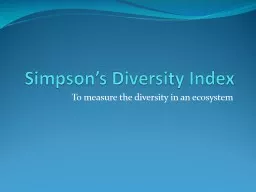/


To measure the diversity in an ecosystem Simpsons Diversity Index Attempts to quantify the diversity variety of an ecosystem There are two components Evenness Richness Evenness Evenness ID: 614128
Download Presentation The PPT/PDF document "Simpson’s Diversity Index" is the property of its rightful owner. Permission is granted to download and print the materials on this web site for personal, non-commercial use only, and to display it on your personal computer provided you do not modify the materials and that you retain all copyright notices contained in the materials. By downloading content from our website, you accept the terms of this agreement.
Slide1
Simpson’s Diversity Index
To measure the diversity in an ecosystemSlide2
Simpson’s Diversity Index
Attempts to quantify the diversity (variety) of an ecosystem.
There are two components:
Evenness
RichnessSlide3
Evenness
Evenness
is a measure of the relative abundance of the different species
within an
area
. (Same amount of each kind of organism)
When the numbers of each type of species is even, the value for the Simpson Diversity Index will be larger.Slide4
Richness = variety
Richness is a measure of the number of kinds of species
More species is “richer” so the value for the index will be higher.Slide5
High Richness Native
Valdivian
Temperate RainforestSlide6
Low richness (
Pinus
Radiata
forest)Slide7
The equation
D
=
N(N
- 1
)
n
(n
-1
)
D
= diversity index
N
= total number of organisms of all species found
n
= number of individuals of a particular speciesSlide8
How to Calculate
D:
Record the numbers of each species
Calculate n-1 for each species
Find the total number of organisms, N
Calculate the Simpson Diversity Index
D =
N(N – 1)
n(n
-1)Slide9
Let’s Try an Example
You have studied a specific site, and have counted the individuals of five different species.
n
is the total number of organisms of a particular species
.
Species A
12
Species B
3
Species C
7
Species D
4
Species E
9
n
Page 11
Teacher Zone
nature.ca/educationSlide10
Simpson’s Index
∑ n(n - 1) = 264
D
=
∑ n(n - 1)
N(N - 1)
Species A
12
11
132
Species B
3
2
6
Species C
7
6
42
Species D
4
3
12
Species E
9
8
72
∑ n(n - 1)
264
n - 1
n(n - 1)
n
Page 12
Teacher Zone
nature.ca/educationSlide11
Simpson’s Index
D
=
∑ n(n - 1)
N(N - 1)
N - 1 = 34
N(N - 1) = 1190
N =
total number of all individuals
= 35
=
264
N(N - 1)
D
=
264
1190
=
0.22184
This area would score 0.22184 on the Simpson’s Index. The scale ranges from 0–1, with 1 representing the lowest biodiversity. Therefore, the score for this area indicates a high level of biodiversity.Page 13Teacher Zonenature.ca/educationSlide12
Calculate the Simpson’s Diversity Index for each sample
Compare the evenness and richness of each sample.Slide13
Answers
Sample One: 2.99
Sample Two: 1.15
Both have the same richness as there are three species in each area.
Sample One is more even because the numbers of each kind of species are nearly the same.Slide14
A high value of
D
suggests a stable, complex and diverse ecosystem. Slide15
A low value of
D
could suggest pollution, recent colonization or agricultural management.
Deforestation in Chile
Eukalyptus
plantationSlide16
The lowest value of D is 1.0
(
monoculture)Slide17
Compare Simpson’s Diversity Index for a tropical rainforest
vs
a desertSlide18
Biodiversity at Sites in Honduras
The following calculations are based on sampling conducted in Honduras by Canadian Museum of Nature research scientist Bob Anderson.
Site
N
N(N - 1)
∑ n(n - 1)
D
Species
Richness
Cerro Montecristo
2996
7 120 892
1 600 002
0.2247
61
El Pital 2050 m
233
54 056
6856
0.1268
22
El Pital 2650 m
5411
29 273 510
12 873 694
0.4398
46
Cerro Puca
311
96 410
19 126
0.1984
27
Santa Barbara
839
703 082
55 514
0.0789
44
Page 14
Teacher Zone
nature.ca/educationSlide19
Biodiversity at Sites in Honduras
Which site has the highest species richness?
Which site is the most diverse according to the Simpson’s Index? (HINT: Has the lowest D).
Do any sites have both a low Simpson’s Index and high species richness? Which one(s)?
Page 15
Teacher Zone
nature.ca/education